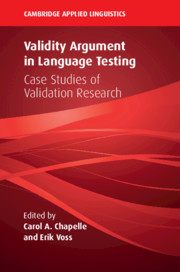Book contents
- Validity Argument in Language Testing
- The Cambridge Applied Linguistics Series
- Validity Argument in Language Testing
- Copyright page
- Contents
- Figures
- Tables
- Contributors
- Series Editor’s Preface
- 1 Introduction to Validity Argument in Language Testing and Assessment
- Part I Basic Concepts and Uses of Validity Argument in Language Testing and Assessment
- Part II Investigating Score Interpretations
- Part III Investigating Score Uses and Consequences
- 10 Justifying the Interpretation and Use of an ESL Writing Final Examination
- 11 An Argument for Use of a Test of Productive Grammatical Ability for Placement into Writing Classes
- 12 Investigating the Consequences of an ESL Placement Test
- Part IV Conclusion
- Index
- References
12 - Investigating the Consequences of an ESL Placement Test
from Part III - Investigating Score Uses and Consequences
Published online by Cambridge University Press: 14 January 2021
- Validity Argument in Language Testing
- The Cambridge Applied Linguistics Series
- Validity Argument in Language Testing
- Copyright page
- Contents
- Figures
- Tables
- Contributors
- Series Editor’s Preface
- 1 Introduction to Validity Argument in Language Testing and Assessment
- Part I Basic Concepts and Uses of Validity Argument in Language Testing and Assessment
- Part II Investigating Score Interpretations
- Part III Investigating Score Uses and Consequences
- 10 Justifying the Interpretation and Use of an ESL Writing Final Examination
- 11 An Argument for Use of a Test of Productive Grammatical Ability for Placement into Writing Classes
- 12 Investigating the Consequences of an ESL Placement Test
- Part IV Conclusion
- Index
- References
Summary
Following the argument-based approach to validity, this chapter focuses on the inference about the positive consequences of an academic ESL placement test (EPT) score use on major stakeholders: ESL instructors and ESL students at a university. The assumptions underlying this inference are that the decisions about ESL course placement are justifiable and comprehensible to test stakeholders, that the decisions are beneficial for ESL learners’ improvement of academic English proficiency, and that the decisions are beneficial for ESL learners’ academic achievement at the university. The assumptions were examined using mixed methods that included interviews, pre- and post-course analyses of students’ performances in ESL classes, and an analysis of the predictive power of the EPT results on students’ academic achievement. The results indicated the positive perceptions of the EPT placement decisions as reported by most of the ESL students and instructors, but variation in the degree of improvement was identified in the ESL courses. ESL students’ performance on the EPT predicted their first-year academic achievement at the university to some degree, highlighting the importance of English proficiency in ESL students’ academic success and the potential impact of the EPT placement decisions on students’ English language learning and overall academic performance.
Keywords
Information
- Type
- Chapter
- Information
- Validity Argument in Language TestingCase Studies of Validation Research, pp. 294 - 316Publisher: Cambridge University PressPrint publication year: 2021
References
Accessibility standard: Unknown
Why this information is here
This section outlines the accessibility features of this content - including support for screen readers, full keyboard navigation and high-contrast display options. This may not be relevant for you.Accessibility Information
- 1
- Cited by
